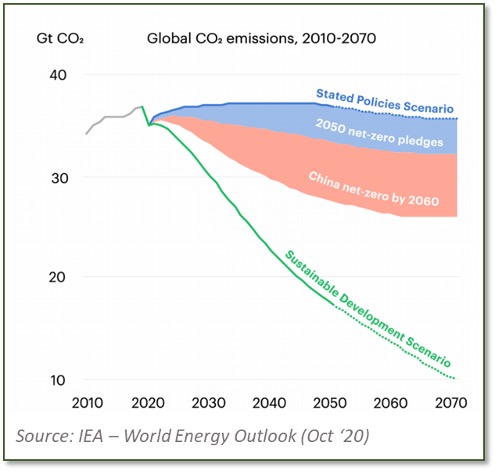Decarbonisation – facts versus fiction
- 17 October 2020
- Posted by: Future Energy
- Category: Energy

Many countries and companies are now taking on the challenge of becoming net zero GHG/CO2 emitters by 2050. Increasingly, the cost of solar, wind and geothermal are very attractive compared to crude oil and gas developments.
However, many more companies and governments need to take on the challenge and develop meaningful master plans to deliver net zero carbon emissions.
This chart from the recent flagship IEA report shows how much further humanity needs to go. Some countries have embraced this challenge even though they have high levels of GHG emissions from legacy industries. Many countries face resistance to reducing emissions due to the significant impact on jobs in emission intensive industries such as coal fired power plants as in Poland and Germany and steel and cement manufacturing in many advancing economies. There remains a significant gap between commitments made to date and the goal of net carbon neutral emissions.
There was a breakthrough announcement recently with China stating that it will aim to achieve carbon neutrality by 2060. As one of the largest emitters, it will have profound implications for their energy development. Our recent webinar where keynote speaker David Sandalow described China’s current approach to developing renewable energy as well as highlighting the alarming rate of coal fired power plant construction. It will be challenging to square the circle.
The issues are many.
For developing countries such as Kenya who have attractive crude oil discoveries in Turkana, the country is patiently developing its renewable resources, particularly geothermal and wind to provide electricity to its citizens. They are at risk of losing tax revenue and jobs from not developing several hundred million barrels of crude oil resources now discovered. Environmental issues are many for this type of development. Has anyone considered the virtue of CO2 carbon capture usage and storage (CCUS) which could mitigate the emission of CO2 from this development.
Renewable energy development has its own ESG challenges as the footprint and impact on local communities and biodiversity need to be understood and mitigated. For example, traditional hydro projects such as Three Gorges and Inga can flood thousands of hectares of land and displace millions of people.
Future Energy Partners (FEP) tackles and provides solutions for the toughest issues in the transition to cleaner energy. We bring together the expertise needed to help companies and countries develop a practical decarbonisation roadmap.
We are grateful to Future Energy Partner for helping us though the ISO certification process. The implementation of ISO standards is what differentiates as a company from our competitors and demonstrates our commitment to Occupational Health and Safety Management.


Leave a Reply Cancel reply
You must be logged in to post a comment.
